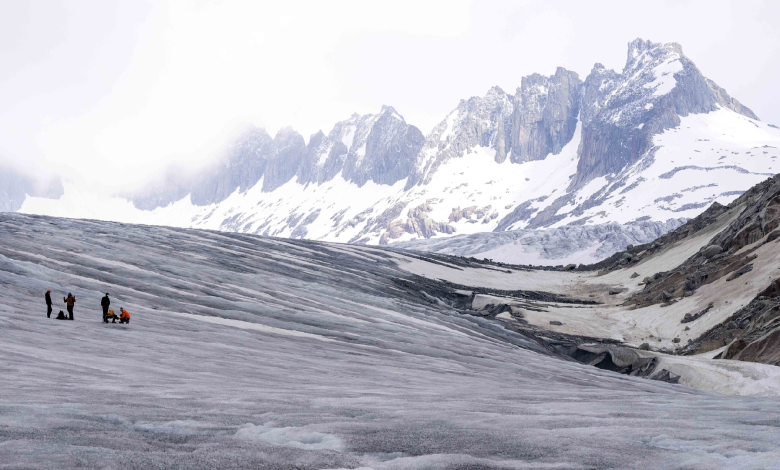Despite snowy winter, Swiss glaciers 'on track to disappear'


A snowy winter provided no respite for Switzerland’s glaciers, which shed 2.4 percent of their volume in a year, with Saharan sand accelerating the summer melt.
The past 12 months have been “exceptional both in terms of accumulation and melt” for Swiss glaciers, a Glacier Monitoring in Switzerland (GLAMOS) study showed Tuesday.
Despite concerns about accelerated glacier melt due to human-induced climate change, the ice loss in Swiss glaciers this year was less severe than in the previous two years.
In 2022 and 2023, Swiss glaciers lost over 10 percent of their volume. However, excluding those exceptional years, the annual volume loss in recent decades has typically ranged between one and three percent.
The 2.4 percent glacier shrinkage this year was well above the 1.9 percent annual average between 2010 and 2020.
It amounted to a “massive loss of ice again,” GLAMOS head Matthias Huss said.
The glaciers, he warned, “are retreating faster and faster” and “are on track to disappear.”
“They will only be there in 100 years if we manage to stabilize the climate.”
<img src='https://news.cgtn.com/news/2024-10-01/Despite-snowy-winter-Swiss-glaciers-on-track-to-disappear–1xlxbwlBK4E/img/4b38655db157439697bbc5c77fa3ed7f/4b38655db157439697bbc5c77fa3ed7f.jpeg' alt='Swiss Federal Institute of Technology glaciologist and head of the Swiss measurement network 'GLAMOS,' Matthias Huss, work at the Rhone glacier with his team in Switzerland, June 16, 2023. /CFP'
‘Not surprised’
GLAMOS researchers did extensive measurements at 20 glaciers in September and extrapolated the findings to Switzerland’s 1,400 glaciers.
It determined that Swiss glacier volume will total 46.4 cubic kilometers at the end of this year, nearly 30 cubic kilometers less than in 2000.
The ice loss in 2024 was especially “considerable … given the strongly above-average snow coverage at the end of winter,” the study said.
Up until June, Swiss glaciers benefitted from winter snowfall 30 percent above average and a rainy start to the summer.
“I hoped for a better result for 2024, especially after this snow-rich winter and the good situation we had into June,” Huss said.
Now, he said he was “disappointed” but “not too surprised.”
“We are living in a time with rapid climate change, and glaciers are just not able to keep up with the speed the climate is warming,” he said.
“Under the present climate situation … it’s not possible to stabilize glaciers, even with an optimal winter.”
The study said “very high” temperatures in July and August, coupled with a lack of fresh high-altitude snowfall, helped drive “the significant glacier mass losses.”
August was particularly hot, and that month actually saw record-high glacier mass losses, GLAMOS said.
The third crucial factor, the report said, was the fact that winds during the winter and spring of 2024 repeatedly brought “substantial amounts of Saharan dust into the Alps.”
The contaminated snow absorbed more heat and melted faster, more quickly depriving the glaciers of their protective snow coating.
While GLAMOS researchers have yet to quantify the net effect of the Saharan dust on the 2024 ice loss, the study said “an increase in melt rates of 10-20 percent compared to normal conditions appears plausible.”
<img src='https://news.cgtn.com/news/2024-10-01/Despite-snowy-winter-Swiss-glaciers-on-track-to-disappear–1xlxbwlBK4E/img/60390bf31c3c411ba8f2bf32b7296da8/60390bf31c3c411ba8f2bf32b7296da8.jpeg' alt='An aerial photograph taken on August 24, 2023 above Gletsch in the Swiss Alps shows insulating foam covering a part of the Rhone Glacier to prevent it from melting, exposing small glacial lakes on its surface due to the ice melting. /CFP'
Shifting border
The glacier melt is having far-reaching impacts.
Switzerland and Italy have adjusted their mountain border under the Matterhorn peak after the glaciers that historically marked the frontier receded.
And with less ice, far less melt water is reaching downstream areas in the summer when it is needed, GLAMOS pointed out.
This, it warned, could “pose important challenges for the future management of water resources… especially during drought periods.”
Huss stressed the urgent need to rein in climate change.
The United Nations has warned that the world remains far off track to meet the 2015 Paris climate accord goals, aiming to keep global temperature rises below 1.5 degrees Celsius above pre-industrial levels.
But Huss fears that with the world wracked by multiple conflicts and crises, decision-makers are not giving climate action appropriate attention.
The glaciers, he said, “are just illustrating every year again that there is an urgent need to act now, and not in one or two or three decades.”

